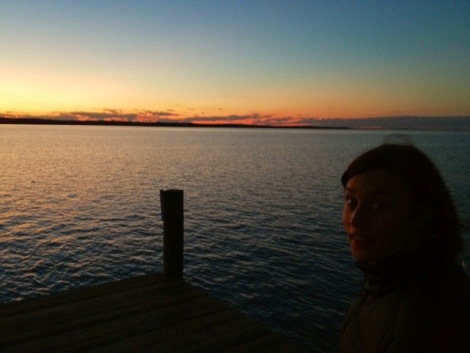
America’s oyster future looks to be poised for an enormous rebound. During the gilded age, Americans and Europeans alike ate enormous quantities of the storied bivalve. Today however, an average American eats only a quarter pound of oysters over the course of an entire year. The French on the other hand never gave up their oyster lust. The average Frenchman eats a whopping 4 pounds of oysters in a typical year. Considering the fact that oyster meat weighs next to nothing, 4 pounds is an enormous number. Eating 16 times the amount of an average American for ANY food, when considering the ever expanding Yankee waistline, is no small feat. I am confident America will eat away a large portion of that oyster deficit given the green shoots we are seeing in North American oyster farming.
While our industry is burgeoning, our status is akin to America’s wine industry of the early 1980s. While we may be adolescent farmers, our ambition runs deep. Many oyster growers have focused on scale, growing enormous quantities of oysters in a market still trying to find its sea legs. These oysters are what I equate to the discount gallons of jug wine sold on the bottom shelf at the local grocery store. With little thought given to finding a pristine, favorable growing area or a process customized to match it, some of these oysters are YAAAWN, meh, ho hum. Crafting a unique process designed for a highly complicated estuarine environment that produces a great tasting oyster is hard, really hard (and did I mention really expensive). So most growers just avoid the brain damage, regulatory hassles, and expense. These oyster farmers opt to follow the same boiler plate recipe others use and try to grow large amounts of oysters. Adding to this problem is the fact that these growers don’t even consider developing a market or brand for their oysters. These farmers expect to dump millions of oysters off at their local distributor all at once, and go home counting their cash. Well it doesn’t work that way. These growers will and should fail.
Only now are some oyster farmers daring to craft artisanal, boutique oysters with a taste specific to the minerals and salinity of the waters in which they cultivate their seed. We are beginning to hear the term merroir tossed around as a way to describe the unique growing environment’s impact on the taste of the oyster. Just as the soils are recognized as an integral component of the terroir in which wine grapes are grown, the concept of merroir for oysters is taking root. This renaissance will create an explosion of new oyster micro appellations throughout America’s estuaries. Less is more here. Small quantity, boutique oyster farmers who maniacally fuss about their oysters will be the only survivors capable of holding their price in what is certain to become a very crowded market. This is the direction Anderson’s Neck is headed.
There are however, environmental obstacles on our industry’s horizon that must be addressed. Sea level rise is a real issue. Changing salinity levels alter where and what type of strain of oyster an estuary can support. If you are still unconvinced about our rising oceans, please plan a visit to our farm. We can show you the ever receding shoreline and how it has changed over the centuries. The erosion has accelerated in the past few years at a pace that can be described as nothing short of alarming. This is a real problem. We will be forced to face sea level rise head on, whether we are ready or not.
Of all environmental problems, ocean acidification is perhaps the most daunting challenge oysters face. While not as problematic yet in the Atlantic, Pacific oyster farms are taking a beating. Baby oysters can only tolerate a certain level of acidity before the caustic water eats away their protective shells and causes them to die. In the past few years, shellfish farms in the Pacific Northwest have seen die offs of their baby oysters exceeding 70% caused by excessive carbon dioxide induced acidification. What the magnitude of this problem will be for East Coast shellfish farms is currently unknown. The western oyster however, the proverbial canary in the coal mine, is telling us a problem is looming that all creatures of the sea will soon face.
Despite these environmental challenges, we remain optimistic. The oyster is an engineering marvel in the field of biological survival. Oysters cannot move, so they are forced through brutal Darwinian selection to pass on only the fittest, disease resistant DNA. Their plight is equivalent to a compilation of Bruce Lee fight scenes run in a continuous loop inside each oyster, every hour of every day, of every year (see video if you haven’t watched Bruce Lee in a while). This sedentary bivalve battles countless ninja like bacteria, viruses, and predators as it passes up to 50 gallons of water laden invaders through its gills each day in an effort to eat and breathe. It should be no surprise that when scientists decoded oyster DNA, they found the unassuming bivalve had more genes than a human being! Wow, based on that, we will place our bet on the almighty oyster finding a way to survive.
Just like wine, and now craft beer, America will soon have a booming artisanal oyster industry. Oyster growers throughout the country are tweaking ancient cultivation techniques on our waterfront farms to produce great tasting and environmentally friendly oysters. I put faith in American ingenuity and hard work. Just like oysters, die hard aquapreneurs are survivors. This resourceful group will continue to combine science with artisanal flare to overcome both known and emerging challenges. The result will be a bounty of varied oysters in both taste and appearance grown throughout America’s estuaries. From where we sit as artisan oyster farmers, America’s oyster futures certainly look bright, very bright indeed!

